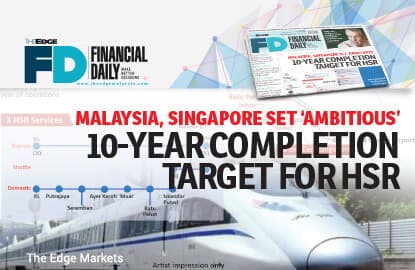
This article first appeared in The Edge Financial Daily, on July 20, 2016.
PUTRAJAYA: As if a project to build a high-speed rail (HSR) traversing more than 350km isn’t already a huge undertaking, both the Malaysian and Singaporean premiers have set a 10-year deadline for the project to be completed and for the HSR to become fully operational, a target which Singapore Prime Minister Lee Hsien Loong himself has termed as “ambitious”.
Both countries inked a memorandum of understanding (MoU) to kick-start the HSR project yesterday, with a view to execute a legally binding bilateral agreement by year end.
To start the ball rolling, an international tender will be called next month to find a joint development partner to provide technical support to both countries.
The 2026 target to get the Kuala Lumpur-Singapore HSR fully operational is indeed a “tight” one, said Prime Minister Datuk Seri Najib Razak after the MoU was signed yesterday.
But he believes it is doable as long as both the Malaysia and Singapore governments work together and do their level best to meet the target.
“Once we get the business model right, then [even] while the world economy is rather volatile and uncertain, the project itself can be finalised,” Najib said.
To Lee, the project has many complexities. “Like a very complicated jigsaw puzzle. We must make sure that we get all those things right in order to get the project done in the most expeditious time frame.”
Lee shared that it took Singapore over 12 years to complete its mass rapid transit. “The HSR, what more with it involving two countries, is a really ambitious undertaking with a 10-year timeline.”
But the question over how much each of these two countries’ public and private sectors will have to fork out for the HSR remains. Minister in the Prime Minister’s Department Datuk Abdul Rahman said the construction cost may be borne equally by both Malaysia and Singapore.
“Much of the track will be in Malaysia, and only about 15km will be in Singapore. Of course, we are not looking at the land, we [are] looking at the cost. Building 15km underground in Singapore will probably cost as much [as Malaysia building its portion fully above ground].
“It will be an equitable, fair percentage for both countries. But I am not at liberty to disclose these figures until the bilateral agreement is signed,” he told reporters.
According to joint statement issued by both governments yesterday, Singapore and Malaysia both agreed that each will take responsibility for developing, constructing and maintaining the civil infrastructure and stations within their own countries. In Malaysia, the responsibility will fall on MyHSR Corp Sdn Bhd, while the Land Transport Authority will undertake the same in Singapore. Both will be known as InfraCos.
Through international tenders, an assets company (AssetsCo) will be appointed to provide and maintain the HSR trains and its associated systems — such as track, power, signalling and telecommunications.
Two train operating companies (OpCos) will be appointed to operate the HSR services. They will have to pay train lease fees to the AssetsCo, and a concession fee to the InfraCos.
The HSR will have eight stations — a terminus each in Bandar Malaysia and Singapore, and six intermediate stations in Putrajaya, Seremban, Ayer Keroh, Muar, Batu Pahat and Iskandar Puteri.
The domestic service that runs within Malaysia will be operated by OpCo Domestic, while the 90-minute express cross-border service between Bandar Malaysia and Singapore will run by OpCo International. The latter will also be managing the shuttle service that connects Iskandar Puteri and Singapore.
Najib said the HSR will create multiplier effects to both Malaysia and Singapore, with the governments expecting 30,000 jobs to be created.
“This will not just benefit the major cities, but will change the smaller towns in-between,” he said, naming Seremban, Batu Pahat and Muar as some of the potential beneficiaries.
According to Phillip Mutual Bhd chief investment officer Ang Kok Heng, property developers and construction companies should benefit from the HSR, though most of the components will be imported.
The names of UEM Sunrise Bhd, Sime Darby Bhd, and Ekovest Bhd have been bandied about by analysts and fund managers as potential beneficiaries of the project, given their huge land banks, most of which are near the planned HSR.
Gamuda Bhd and MMC Corp Bhd, meanwhile, have the experience in building rail-based infrastructure.
However, with a 10-year horizon, AllianceDBS Research Sdn Bhd head of Malaysia Research Bernard Ching thinks it is too early to see which stock will benefit from HSR, and how. “The timing of [the] implementation is still fluid. The governments have just signed the MoU. There are more steps that need to be taken.”